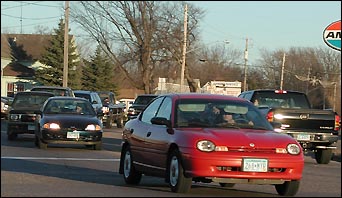Minute with Mike
Community needs to decide about Highway 23
 To say that the future of this community will be decided in the next year is an overstatement, but not much of one.
To say that the future of this community will be decided in the next year is an overstatement, but not much of one.
If all goes as scheduled, a plan for future improvements for this community's most important road will mostly be decided when MnDOT presents a draft version of an Environmental Impact Statement (EIS) to the public next fall.
MnDOT launched their current study on the road last summer. Traffic counts and traffic surveys were conducted in August and September by the consulting firm handling the study.
The study will examine five possible routes for Highway 23: keeping it exactly the same as it is now; improving the current route through town (adding traffic lights, turning lanes, etc.), and three bypass routes.
The possible bypass routes are (coming from Willmar): heading straight along the golf course and around the city to the south and east; staying on the present route until the junction with Highway 55, crossing the river, and skirting the town to the north; and leaving 23 well to the west of town (possibly along the county line) and circling the city to the west and north.
Whatever gets decided in the next year will not be built immediately. In fact, there is no set timetable for construction. It could take two, or ten years, for the new alignment to become a reality, depending on the funds MnDOT has for construction.
Whatever gets decided will eventuate, so this community has a major decision in front of it.
Let's look at some MnDOT history before we proceed. The need to upgrade Highway 23 in Paynesville is the result of a 1997 survey that looked at traffic patterns from Richmond to Willmar. The widening of 23 to four lanes from I-94 to Richmond was already in progress when that survey was done, and that survey added the widening of 23 from Willmar to New London, another project nearing actual construction, unless the residents in Spicer who oppose the plan find a way to stop it at the last minute.
The survey in Paynesville looks only at the city. Basically, it's concerned with getting the highway from one end of town to the other. This survey is not looking at making all of Highway 23, from Willmar to St. Cloud, into a four-lane road. MnDOT's traffic projections in 1997, which went out 20 years, to 2017, didn't indicate any need for a four-lane road by Roscoe or Hawick.
Nothing is certain for Paynesville, either. While the report could recommend no changes, this seems unlikely. The 1997 survey indicated a need for improvements and drivers would undoubtedly agree.
The question is what should be done. Engineers from MnDOT and their consulting firm play this pretty close to the vest. I like to label their generalities as engineerspeak; you get phrases like study all the factors and select the best possible route.
Both the capacity (number of lanes) and the alignment (route) of the highway are in question and will get answered separately. The recommendation could be to make slight improvements through town or turn the existing alignment into a super-3 all through town.
Or a bypass could be recommended. There's hardly room for a super-3 through town so a four-lane road would seem highly unlikely. But a bypass would not have to be a four-lane either. A bypass route could be selected and land purchased to make it four lanes eventually, but it might start as a two-lane bypass.
I've had opportunities to discuss Highway 23 a couple times recently, first at a Chamber of Commerce noon lunch in November and then at a school board meeting last week. Obviously, the school - with two of its buildings having their main entrances on Highway 23 - and the business community - which will be influenced in a variety of ways by any change - have great interest in the future of Highway 23.
One of the most interesting things at the Chamber meeting were the comments of Jeff Bertram, a former state legislator who had experience working with MnDOT when the plans for Highway 23 through Rockville and Cold Spring were made. MnDOT, he stressed, responds to political pressure from the community.
In Rockville, the community initially wanted to keep the road through town, but changed its mind when it saw the plans and saw what would be done to their town in order to construct a four-lane road through the town. In Cold Spring, on the other hand, a group presented a united front immediately for a four-lane road through town and that's what they're getting, despite any second-guessing now.
His message is that if our community wants to make a decision about Highway 23 in our best interests, then everyone needs to understand the importance of the MnDOT study, consider the impact of the different routes, and contribute to the final decision.
Whether you make it a New Year's resolution or not, expect to hear a lot about Highway 23 in 2002.
Contact the author at paypress@lkdllink.net | Return to Viewpoint